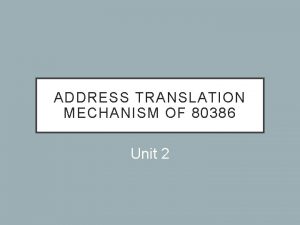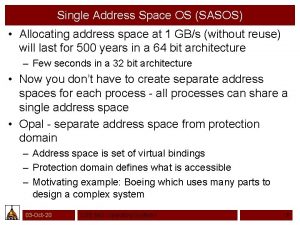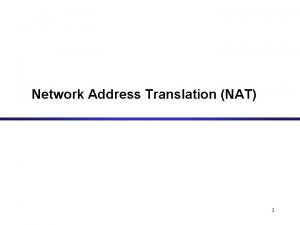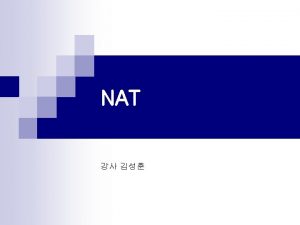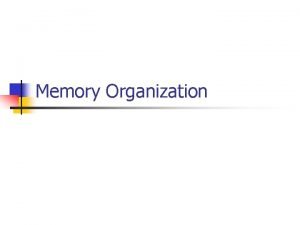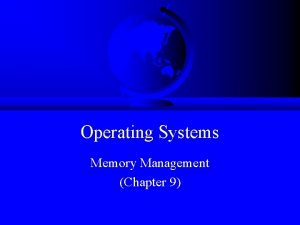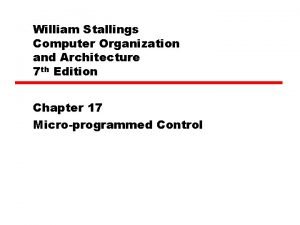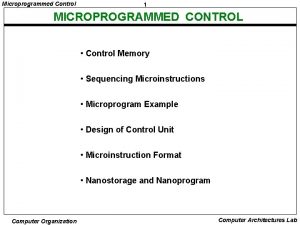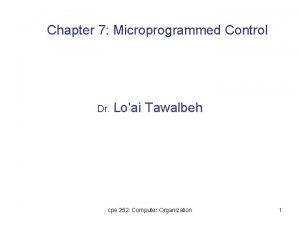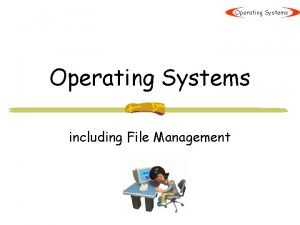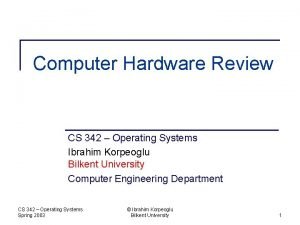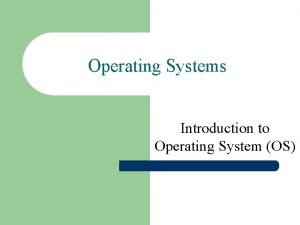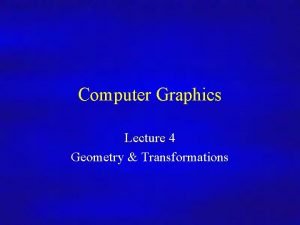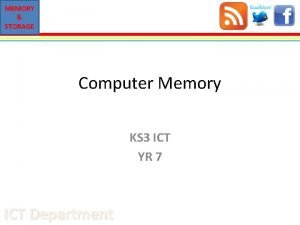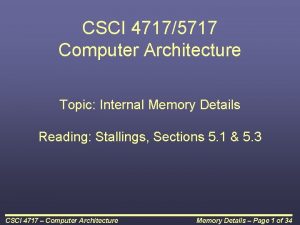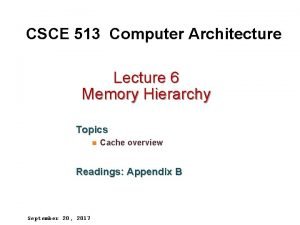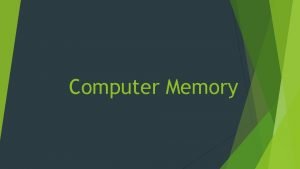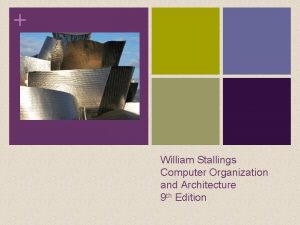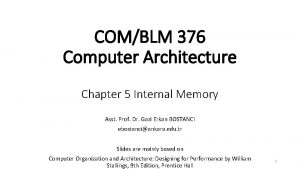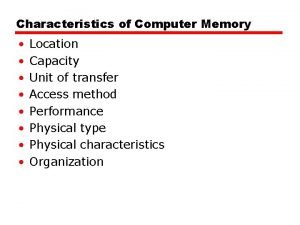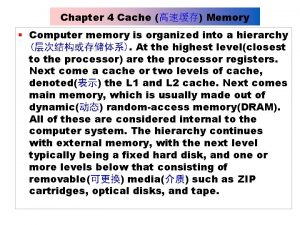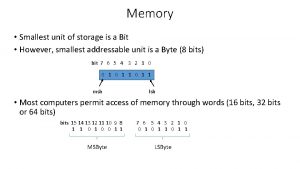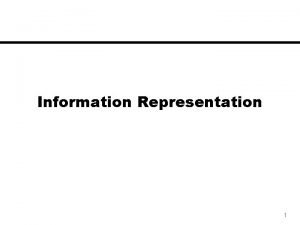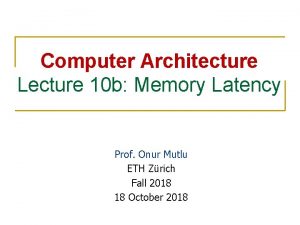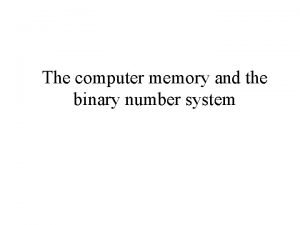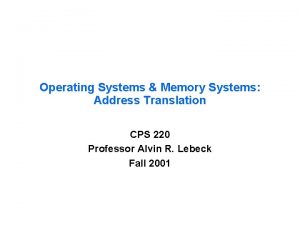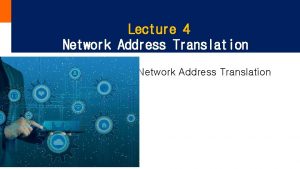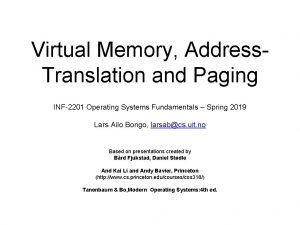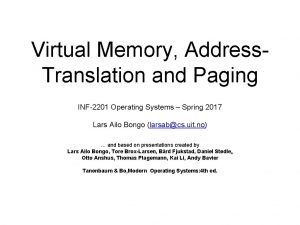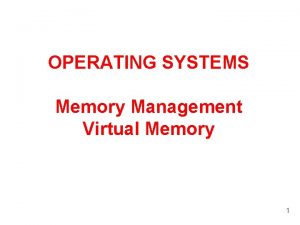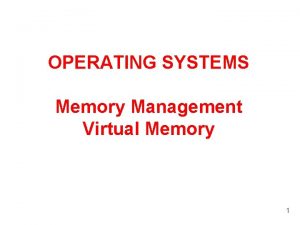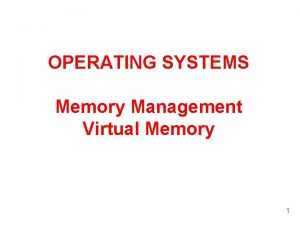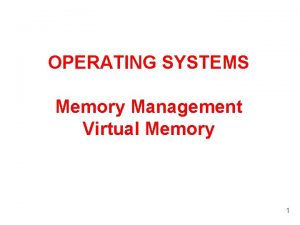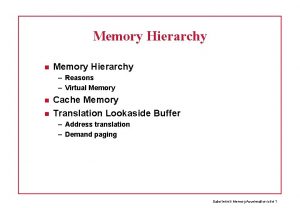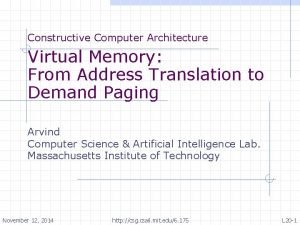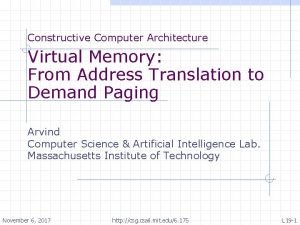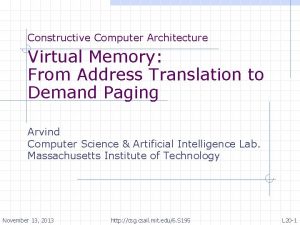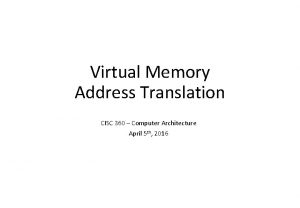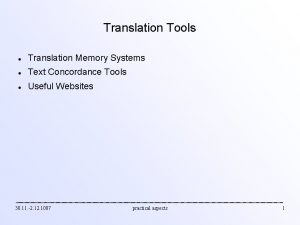Operating Systems Memory Systems Address Translation Computer Science










































![Careful Page Mapping [Kessler 92, Bershad 94] • Select a page frame such that Careful Page Mapping [Kessler 92, Bershad 94] • Select a page frame such that](https://slidetodoc.com/presentation_image/354014329d9870984f3a31241f0461c1/image-43.jpg)








![Dynamic Page Coloring • Cache Miss Lookaside (CML) buffer [Bershad 94] – proposed hardware Dynamic Page Coloring • Cache Miss Lookaside (CML) buffer [Bershad 94] – proposed hardware](https://slidetodoc.com/presentation_image/354014329d9870984f3a31241f0461c1/image-52.jpg)
- Slides: 52

Operating Systems & Memory Systems: Address Translation Computer Science 220 ECE 252 Professor Alvin R. Lebeck Fall 2006

Outline • Finish Main Memory • Address Translation – basics – 64 -bit Address Space • Managing memory • OS Performance Throughout • Review Computer Architecture • Interaction with Architectural Decisions © Alvin R. Lebeck 2001 CPS 220 2

Fast Memory Systems: DRAM specific • Multiple RAS accesses: several names (page mode) – 64 Mbit DRAM: cycle time = 100 ns, page mode = 20 ns • New DRAMs to address gap; what will they cost, will they survive? – Synchronous DRAM: Provide a clock signal to DRAM, transfer synchronous to system clock – RAMBUS: reinvent DRAM interface (Intel will use it) » Each Chip a module vs. slice of memory » Short bus between CPU and chips » Does own refresh » Variable amount of data returned » 1 byte / 2 ns (500 MB/s per chip) – Cached DRAM (CDRAM): Keep entire row in SRAM © Alvin R. Lebeck 2001 3

Main Memory Summary • Big DRAM + Small SRAM = Cost Effective – Cray C-90 uses all SRAM (how many sold? ) • Wider Memory • Interleaved Memory: for sequential or independent accesses • Avoiding bank conflicts: SW & HW • DRAM specific optimizations: page mode & Specialty DRAM, CDRAM – Niche memory or main memory? » e. g. , Video RAM for frame buffers, DRAM + fast serial output • IRAM: Do you know what it is? © Alvin R. Lebeck 2001 4

Review: Reducing Miss Penalty Summary • Five techniques – – – Read priority over write on miss Subblock placement Early Restart and Critical Word First on miss Non-blocking Caches (Hit Under Miss) Second Level Cache • Can be applied recursively to Multilevel Caches – Danger is that time to DRAM will grow with multiple levels in between © Alvin R. Lebeck 2001 5

Review: Improving Cache Performance 1. Reduce the miss rate, 2. Reduce the miss penalty, or 3. Reduce the time to hit in the cache © Alvin R. Lebeck 2001 6

Review: Cache Optimization Summary Technique MR MP Larger Block Size + Higher Associativity + Victim Caches + Pseudo-Associative Caches HW Prefetching of Instr/Data Compiler Controlled Prefetching Compiler Reduce Misses + Priority to Read Misses Subblock Placement Early Restart & Critical Word 1 st Non-Blocking Caches Second Level Caches Small & Simple Caches – Avoiding Address Translation Pipelining Writes © Alvin R. Lebeck 2001 HT – + + + + Complexity 0 – 1 2 + + 0 1 1 3 2 0 + 1 2 2 3 2 2 7

System Organization Processor interrupts Cache Core Chip Set I/O Bus Main Memory Disk Controller Disk © Alvin R. Lebeck 2001 Disk Graphics Controller Graphics Network Interface Network 8

Computer Architecture • Interface Between Hardware and Software Applications Operating System CPU Software Compiler Memory Multiprocessor © Alvin R. Lebeck 2001 This is IT I/O Networks Hardware 9

Memory Hierarchy 101 Very fast <1 ns clock Multiple Instructions per cycle P $ Memory SRAM, Fast, Small Expensive DRAM, Slow, Big, Cheap (called physical or main) Magnetic, Really Slow, Really Big, Really Cheap => Cost Effective Memory System (Price/Performance) © Alvin R. Lebeck 2001 10

Virtual Memory: Motivation • Process = Address Space + thread(s) of control • Address space = PA Virtual Physical – programmer controls movement from disk – protection? – relocation? • Linear Address space – larger than physical address space » 32, 64 bits v. s. 28 -bit physical (256 MB) • Automatic management © Alvin R. Lebeck 2001 CPS 220 11

Virtual Memory • Process = virtual address space + thread(s) of control • Translation – VA -> PA – What physical address does virtual address A map to – Is VA in physical memory? • Protection (access control) – Do you have permission to access it? © Alvin R. Lebeck 2001 12

Virtual Memory: Questions • How is data found if it is in physical memory? • Where can data be placed in physical memory? Fully Associative, Set Associative, Direct Mapped • What data should be replaced on a miss? (Take Compsci 210 …) © Alvin R. Lebeck 2001 13

Segmented Virtual Memory • Virtual address (232, 264) to Physical Address mapping (230) • Variable size, base + offset, contiguous in both VA and PA Virtual 0 x 1000 0 x 6000 Physical 0 x 0000 0 x 1000 0 x 2000 0 x 9000 0 x 11000 © Alvin R. Lebeck 2001 14

Intel Pentium Segmentation Physical Address Space Logical Address Seg Selector Offset Global Descriptor Table (GDT) Segment Descriptor Segment Base Address © Alvin R. Lebeck 2001 CPS 220 15

Pentium Segmention (Continued) • Segment Descriptors – Local and Global – base, limit, access rights – Can define many • Segment Registers – contain segment descriptors (faster than load from mem) – Only 6 • Must load segment register with a valid entry before segment can be accessed – generally managed by compiler, linker, not programmer © Alvin R. Lebeck 2001 CPS 220 16

Paged Virtual Memory • Virtual address (232, 264) to Physical Address mapping (228) – virtual page to physical page frame Virtual page number Offset • Fixed Size units for access control & translation Virtual 0 x 1000 0 x 6000 Physical 0 x 0000 0 x 1000 0 x 2000 0 x 9000 0 x 11000 © Alvin R. Lebeck 2001 17

Page Table • Kernel data structure (per process) • Page Table Entry (PTE) – VA -> PA translations (if none page fault) – access rights (Read, Write, Execute, User/Kernel, cached/uncached) – reference, dirty bits • Many designs – Linear, Forward mapped, Inverted, Hashed, Clustered • Design Issues – support for aliasing (multiple VA to single PA) – large virtual address space – time to obtain translation © Alvin R. Lebeck 2001 CPS 220 18

Alpha VM Mapping (Forward Mapped) • “ 64 -bit” address divided into 3 21 segments seg 0/1 – seg 0 (bit 63=0) user code/heap – seg 1 (bit 63 = 1, 62 = 1) user stack – kseg (bit 63 = 1, 62 = 0) base kernel segment for OS + • Three level page table, each one page – Alpha 21064 only 43 unique bits of VA – (future min page size up to 64 KB => 55 bits of VA) • PTE bits; valid, kernel & user read & write enable (No reference, use, or dirty bit) – What do you do for replacement? © Alvin R. Lebeck 2001 L 1 10 L 2 10 L 3 PO 10 13 + + phys page frame number 19

Inverted Page Table (HP, IBM) Virtual page number • One PTE per page frame Offset Inverted Page Table (IPT) Hash VA PA, ST – only one VA per physical frame • Must search for virtual address • More difficult to support aliasing • Force all sharing to use the same VA Hash Anchor Table (HAT) © Alvin R. Lebeck 2001 CPS 220 20

Intel Pentium Segmentation + Paging Logical Address Dir Table Seg Selector Physical Address Space Linear Address Space Offset Page Table Global Descriptor Table (GDT) Page Dir Segment Descriptor Segment Base Address © Alvin R. Lebeck 2001 CPS 220 21

The Memory Management Unit (MMU) • Input – virtual address • Output – physical address – access violation (exception, interrupts the processor) • Access Violations – – – not present user v. s. kernel write read execute © Alvin R. Lebeck 2001 22

Translation Lookaside Buffers (TLB) • Need to perform address translation on every memory reference – 30% of instructions are memory references – 4 -way superscalar processor – at least one memory reference per cycle • Make Common Case Fast, others correct • Throw HW at the problem • Cache PTEs © Alvin R. Lebeck 2001 CPS 220 23

Fast Translation: Translation Buffer • Cache of translated addresses • Alpha 21164 TLB: 48 entry fully associative Page Number 1 Page offset 2 v r w tag . . 3 © Alvin R. Lebeck 2001 phys frame 4 . . . 48 48: 1 mux 24

TLB Design • • Must be fast, not increase critical path Must achieve high hit ratio Generally small highly associative Mapping change – page removed from physical memory – processor must invalidate the TLB entry • PTE is per process entity – Multiple processes with same virtual addresses – Context Switches? • Flush TLB • Add ASID (PID) – part of processor state, must be set on context switch © Alvin R. Lebeck 2001 CPS 220 25

Hardware Managed TLBs • Hardware Handles TLB miss • Dictates page table organization • Compilicated state machine to “walk page table” CPU TLB Control – Multiple levels forward mapped – Linked list for inverted • Exception only if access violation Memory © Alvin R. Lebeck 2001 CPS 220 26

Software Managed TLBs • Software Handles TLB miss • Flexible page table organization • Simple Hardware to detect Hit or Miss • Exception if TLB miss or access violation • Should you check for access violation on TLB miss? CPU TLB Control Memory © Alvin R. Lebeck 2001 CPS 220 27

Mapping the Kernel • Digital Unix Kseg 264 -1 User Stack – kseg (bit 63 = 1, 62 = 0) • Kernel has direct access to physical memory • One VA->PA mapping for entire Kernel • Lock (pin) TLB entry Kernel – or special HW detection Physical Memory Kernel User Code/ Data 0 © Alvin R. Lebeck 2001 28

Considerations for Address Translation Large virtual address space • Can map more things – – files frame buffers network interfaces memory from another workstation • Sparse use of address space • Page Table Design – space – less locality => TLB misses OS structure • microkernel => more TLB misses © Alvin R. Lebeck 2001 CPS 220 29

Address Translation for Large Address Spaces • Forward Mapped Page Table – grows with virtual address space » worst case 100% overhead not likely – TLB miss time: memory reference for each level • Inverted Page Table – grows with physical address space » independent of virtual address space usage – TLB miss time: memory reference to HAT, IPT, list search © Alvin R. Lebeck 2001 CPS 220 30

Hashed Page Table (HP) Virtual page number • Combine Hash Table and IPT [Huck 96] Offset – can have more entries than physical page frames Hashed Page Table (HPT) VA PA, ST • Must search for virtual address • Easier to support aliasing than IPT • Space – grows with physical space • TLB miss – one less memory ref than IPT © Alvin R. Lebeck 2001 CPS 220 31

Clustered Page Table (SUN) VPBN Boff Offset . . . Hash – virtual page block number (VPBN) – block offset VPBN next PA 0 attrib . . . VPBN next PA 0 attrib PA 1 attrib PA 2 attrib PA 3 attrib VPBN next PA 0 attrib • Combine benefits of HPT and Linear [Talluri 95] • Store one base VPN (TAG) and several PPN values © Alvin R. Lebeck 2001 CPS 220 32

Reducing TLB Miss Handling Time • Problem – must walk Page Table on TLB miss – usually incur cache misses – big problem for IPC in microkernels • Solution – build a small second-level cache in SW – on TLB miss, first check SW cache » use simple shift and mask index to hash table © Alvin R. Lebeck 2001 CPS 220 33

Cache Indexing • Tag on each block – No need to check index or block offset • Increasing associativity shrinks index, expands tag Block Address TAG Index Block offset Fully Associative: No index Direct-Mapped: Large index © Alvin R. Lebeck 2001 34

Address Translation and Caches • Where is the TLB wrt the cache? • What are the consequences? • Most of today’s systems have more than 1 cache – Digital 21164 has 3 levels – 2 levels on chip (8 KB-data, 8 KB-inst, 96 KB-unified) – one level off chip (2 -4 MB) • Does the OS need to worry about this? Definition: page coloring = careful selection of va->pa mapping © Alvin R. Lebeck 2001 CPS 220 35

TLBs and Caches CPU VA Tags PA Tags $ TLB PA PA PA L 2 $ TLB MEM Conventional Organization Virtually Addressed Cache Translate only on miss Alias (Synonym) Problem © Alvin R. Lebeck 2001 $ VA PA $ VA VA VA TLB CPU MEM Overlap $ access with VA translation: requires $ index to remain invariant across translation 36

Virtual Caches • Send virtual address to cache. Called Virtually Addressed Cache or just Virtual Cache vs. Physical Cache or Real Cache • Avoid address translation before accessing cache – faster hit time to cache • Context Switches? – Just like the TLB (flush or pid) – Cost is time to flush + “compulsory” misses from empty cache – Add process identifier tag that identifies process as well as address within process: can’t get a hit if wrong process • I/O must interact with cache © Alvin R. Lebeck 2001 CPS 220 37

I/O and Virtual Caches Virtual Cache Physical Addresses I/O is accomplished with physical addresses DMA • flush pages from cache • need pa->va reverse translation • coherent DMA © Alvin R. Lebeck 2001 Processor interrupts Cache Memory Bus I/O Bridge I/O Bus Main Memory Disk Controller Disk Graphics Controller Graphics Network Interface Network 38

Aliases and Virtual Caches 264 -1 User Stack Kernel Physical Memory Kernel User Code/ Data 0 © Alvin R. Lebeck 2001 CPS 220 • aliases (sometimes called synonyms); Two different virtual addresses map to same physical address • But, but. . . the virtual address is used to index the cache • Could have data in two different locations in the cache 39

Index with Physical Portion of Address • If index is physical part of address, can start tag access in parallel with translation so that can compare to physical tag Page Address Tag Page Offset Index Block Offset • Limits cache to page size: what if want bigger caches and use same trick? – Higher associativity – Page coloring © Alvin R. Lebeck 2001 40

Page Coloring for Aliases • HW that guarantees that every cache frame holds unique physical address • OS guarantee: lower n bits of virtual & physical page numbers must have same value; if direct-mapped, then aliases map to same cache frame – one form of page coloring Page Offset Page Address Tag Block Offset Index © Alvin R. Lebeck 2001 CPS 220 41

Page Coloring to reduce misses Cache Page frames • Notion of bin – region of cache that may contain cache blocks from a page • Random vs careful mapping • Selection of physical page frame dictates cache index • Overall goal is to minimize cache misses © Alvin R. Lebeck 2001 CPS 220 42
![Careful Page Mapping Kessler 92 Bershad 94 Select a page frame such that Careful Page Mapping [Kessler 92, Bershad 94] • Select a page frame such that](https://slidetodoc.com/presentation_image/354014329d9870984f3a31241f0461c1/image-43.jpg)
Careful Page Mapping [Kessler 92, Bershad 94] • Select a page frame such that cache conflict misses are reduced – only choose from available pages (no VM replacement induced) • static – “smart” selection of page frame at page fault time • dynamic – move pages around © Alvin R. Lebeck 2001 CPS 220 43

A Case for Large Pages • Page table size is inversely proportional to the page size – memory saved • Fast cache hit time easy when cache <= page size (VA caches); – bigger page makes it feasible as cache size grows • Transferring larger pages to or from secondary storage, possibly over a network, is more efficient • Number of TLB entries are restricted by clock cycle time, – larger page size maps more memory – reduces TLB misses © Alvin R. Lebeck 2001 44

A Case for Small Pages • Fragmentation – large pages can waste storage – data must be contiguous within page • Quicker process start for small processes(? ? ) © Alvin R. Lebeck 2001 CPS 220 45

Superpages • Hybrid solution: multiple page sizes – 8 KB, 16 KB, 32 KB, 64 KB pages – 4 KB, 64 KB, 256 KB, 1 MB, 4 MB, 16 MB pages • Need to identify candidate superpages – Kernel – Frame buffers – Database buffer pools • Application/compiler hints • Detecting superpages – static, at page fault time – dynamically create superpages • Page Table & TLB modifications © Alvin R. Lebeck 2001 CPS 220 46

Page Coloring • Make physical index match virtual index • Behaves like virtual index cache – no conflicts for sequential pages • Possibly many conflicts between processes – address spaces all have same structure (stack, code, heap) – modify to xor PID with address (MIPS used variant of this) • Simplementation • Pick abitrary page if necessary © Alvin R. Lebeck 2001 CPS 220 47

Bin Hopping • Allocate sequentially mapped pages (time) to sequential bins (space) • Can exploit temporal locality – pages mapped close in time will be accessed close in time • Search from last allocated bin until bin with available page frame • Separate search list per process • Simplementation © Alvin R. Lebeck 2001 CPS 220 48

Best Bin • Keep track of two counters per bin – used: # of pages allocated to this bin for this address space – free: # of available pages in the system for this bin • Bin selection is based on low values of used and high values of free • Low used value – reduce conflicts within the address space • High free value – reduce conflicts between address spaces © Alvin R. Lebeck 2001 CPS 220 49

Hierarchical • Best bin could be linear in # of bins • Build a tree – internal nodes contain sum of child <used, free> values • Independent of cache size – simply stop at a particular level in the tree © Alvin R. Lebeck 2001 CPS 220 50

Benefit of Static Page Coloring • Reduces cache misses by 10% to 20% • Multiprogramming – want to distribute mapping to avoid inter-address space conflicts © Alvin R. Lebeck 2001 CPS 220 51
![Dynamic Page Coloring Cache Miss Lookaside CML buffer Bershad 94 proposed hardware Dynamic Page Coloring • Cache Miss Lookaside (CML) buffer [Bershad 94] – proposed hardware](https://slidetodoc.com/presentation_image/354014329d9870984f3a31241f0461c1/image-52.jpg)
Dynamic Page Coloring • Cache Miss Lookaside (CML) buffer [Bershad 94] – proposed hardware device • Monitor # of misses per page • If # of misses >> # of cache blocks in page – must be conflict misses – interrupt processor – move a page (recolor) • Cost of moving page << benefit © Alvin R. Lebeck 2001 CPS 220 52
 Page translation mechanism in 80386
Page translation mechanism in 80386 Virtual memory address translation
Virtual memory address translation Logical memory is broken into
Logical memory is broken into сасос
сасос Sasoss
Sasoss Migrate network address translation
Migrate network address translation Nat in networking
Nat in networking My favorite subject is science because
My favorite subject is science because Types of cache mapping
Types of cache mapping Symbolic microprogram in computer architecture
Symbolic microprogram in computer architecture Semantic translation is
Semantic translation is Number translation using voice translation profiles
Number translation using voice translation profiles Parent functions
Parent functions Noun phrase
Noun phrase Virtual memory in os
Virtual memory in os Virtual memory os
Virtual memory os Memory management operating system
Memory management operating system Prototype in semantics
Prototype in semantics Explicit memory
Explicit memory Long term memory vs short term memory
Long term memory vs short term memory Internal memory and external memory
Internal memory and external memory Primary memory and secondary memory
Primary memory and secondary memory Which memory is the actual working memory?
Which memory is the actual working memory? Virtual memory and cache memory
Virtual memory and cache memory Virtual memory in memory hierarchy consists of
Virtual memory in memory hierarchy consists of Eidetic memory vs iconic memory
Eidetic memory vs iconic memory Shared memory vs distributed memory
Shared memory vs distributed memory Address sequencing in computer architecture
Address sequencing in computer architecture Address sequencing in computer architecture
Address sequencing in computer architecture Loai tawalbeh
Loai tawalbeh Os file management
Os file management Computer hardware review in operating system
Computer hardware review in operating system Hierarchical structure of operating system
Hierarchical structure of operating system Types of transformation in computer graphics
Types of transformation in computer graphics Memory system design
Memory system design Types of computer memory
Types of computer memory Explain virtual memory in computer architecture
Explain virtual memory in computer architecture Computer architecture
Computer architecture Internal memory in computer architecture
Internal memory in computer architecture Computer memory hierarchy
Computer memory hierarchy Short term memory computer
Short term memory computer Presentation on computer memory
Presentation on computer memory Memory organisation in computer architecture
Memory organisation in computer architecture Computer memory hierarchy diagram
Computer memory hierarchy diagram Internal memory in computer architecture
Internal memory in computer architecture Set associative mapping in cache memory
Set associative mapping in cache memory Characteristics of computer memory
Characteristics of computer memory Computer memory system overview
Computer memory system overview Computer memory analogy
Computer memory analogy Smallest unit of memory
Smallest unit of memory Information representation in computer architecture
Information representation in computer architecture Memory latency in computer architecture
Memory latency in computer architecture What is computer memory
What is computer memory
